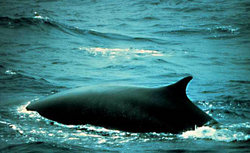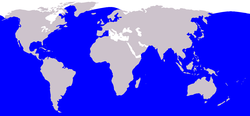Fin Whales
|
|
| Fin Whale Conservation status: Endangered | ||||||||||||||||||
|---|---|---|---|---|---|---|---|---|---|---|---|---|---|---|---|---|---|---|
 | ||||||||||||||||||
| Scientific classification | ||||||||||||||||||
| ||||||||||||||||||
| Binomial name | ||||||||||||||||||
| Balaenoptera physalus (Linneus, 1758) | ||||||||||||||||||
 Fin Whale range |
The Fin Whale (Balaenoptera physalus) is a mammal which belongs to the baleen whales suborder. It is the second largest whale and also the second largest animal ever to have lived, after the Blue Whale. It has a world wide distribution, and in Europe is readily seen in the Bay of Biscay. The Fin Whale was hunted more than any other whale during the twentieth century.
| Contents |
Taxonomy
The Finback has long been known to taxonomists. It was first described by Frederick Martens in 1675 and then again by Paul Dudley in 1725. These descriptions were used as the basis of Carolus Linnaeus' Balaena physalus (1758). The Comte de Lacepede reclassified it as Balaenoptera physalus early in the nineteenth century. The specific name comes from the Greek physa, meaning bellows.
The Fin Whale is a close relative of the Blue Whale taxonomically speaking. Evolutionary divergence occurred between 3 and 5 million years ago. Hybrids between the two species are quite common - for every 1000 Fin Whales there is a hybrid Blue-Fin Whale.
Population groups have split into north-south groups. On account of their migatory patterns (see below), the northern and southern groups do not meet and hence do not interbreed. There has been some genetic drifting and some sources recognise two sub-species B. p. physalus (Northern Fin Whale) and B. p. quoyi (Southern Fin Whale).
Physical description and behaviour
Fin Whales are enormous animals. The longest specimens - typically females found in Southern Hemisphere populations can be up to 26 m in length and weigh 120,000 kg. Males are typically a metre shorter. Northern specimens are between 21 m and 23 m long. Even at birth Fin Whales weigh in excess of 3,000 kg - more than half the weight of a fully grown Indian elephant. They reach their full size at about 10 years old and can live for over 80 years. The gestation period is eleven months to one year. Calves stay close to their mother for about six months.
Fin Whales are usually distinguished by their gigantic size. From this fact only, the only possibilities for confusion when making an identification at size are with the Blue Whale, the Sei Whale, or, in warmer waters, Bryde's Whale. The Fin Whale has a large white patch on its right jaw (and right jaw only, the left jaw is grey). This asymmetry is unique to the Fin Whale amongst cetaceans and is the key to making a full identification. It probably arises because the whale swims on its right side when feeding. The belly and underside of the flippers are white. The rest of the body is grey - with lighter patches on the head roughly demarced from the dark back in V-shapes. 50-100 ventrical pleats or grooves run from the tip of the chin to the navel.
This rorqual is a filter-feeder, using its baleen to strain plankton out of the seawater. An adult has between 260 and 480 baleen plates on each side of the mouth for filtering. It will also feed on fish, squid and crustaceans.
It is a long slim whale with a prominent dorsal fin about three-quarters of the way along the back. The fin is visible soon after the blow when the whale surfaces. It has a 5m vertical single column blow. The whale will blow about five times on each visit to the surface, staying close to the surface for about one and a half minutes each time. The tail remains submerged during the dive sequence. It can dive to depths of 250m and dives last between 10 and 15 minutes.
The Fin Whale is a very fast swimmer amongst whales of its size. Speeds of 20mph are common, and bursts in excess of 25mph have been recorded, which labeled it with the nickname "greyhound of the sea". Breaching is seen but is not common. Fin Whales appear to have an ambivalent attitude to boats.
Like Blue Whales, Fin Whales have been recorded making long, loud, low-frequency noices. Under water, these vocalizations can be detected hundreds of miles from their source. It is undetermined whether the vocalization is used for communication and/or shows of machismo from breeding males.
Population and distribution
Like many of the large rorquals, the Fin Whale is a cosmopolitan species. It is found in all the world's major oceans, and in waters ranging from the polar to the tropical. It is absent only from waters close to the ice pack at both the North and South extremities and relatively small areas of water away from the large oceans, such as the Red Sea, the Persian Gulf, the eastern part of the Mediterranean and the Baltic Sea. The highest population density occurs in temperate and cool waters. It is less densely populated in the hottest, equatorial regions. Deep waters beyond the continental shelf are preferred to shallow waters.
The total population is estimated to be just in excess of 100,000. The largest populations include 24,000 in the Southern Ocean and 14,000 in the North Atlantic between Iceland and Greenland.
Fin Whales are migratory species. A north-south pattern has been proposed for populations in both the northern and southern hemispheres. For southern populations this pattern is believed to be well understood. Animals travel south for the summer and back north for the winter. The precise route of migration appears to be governed by the strength of geo-magnetic fields - Fin Whales preferring low and constant fields strengths to high and variable ones. The northern migration is less well-understood and is probably more patchy particularly in the North Atlantic. There are three suggested reasons for this. One is that the Atlantic Gulf Stream lessens the north-south temperature gradient making migration a less attractive option. Thirdly food may be available in the cold north all year round, again lessening the need for travel. Finally in winter, Fin Whales prefer to stick to deeper colder waters, further from the shore and thus less easily detected by humans wanting to measure their movement.
Human interaction
In the early days of whaling, Fin Whales were safe from the hunters. Their rapid speed enabled them to become a low priority for whalers. However the advent of steam-powered boats and harpoons that exploded on impact took the upper hand away from the Fin Whale. It went on to become the most hunted cetacean in history. 725,000 recorded kills of Fin Whales were made in the twentieth century, causing them to become endangered around the world, and in particular in the Southern and Atlantic Oceans. Whaling of the species reached its peak between 1935 and 1970 when in excess of 30,000 animals were taken annually. Following a morartorium on hunting of Fin Whales enforced since 1985, the Northern and Southern Pacific Oceans populations have recovered somewhat. There may also be some recovery in Antarctic waters. However all populations worldwide remain listed as endangered species on the International Conservation Union Red List. Today about 10 Fin Whales are killed each year by whalers on the west coast of Greenland, under an agreement with the International Whaling Commission to allow subsistence whaling in the area.
Other cetacean dangers caused by humans, including catching in fishing nets, collisions with ships and pollution, are relatively rare in Fin Whales on account of their size, speed and position high in the food chain.

